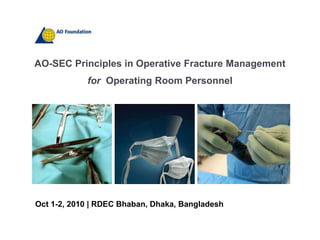
Openfracture
- 1. AO-SEC Principles in Operative Fracture Management for Operating Room Personnel Oct 1-2, 2010 | RDEC Bhaban, Dhaka, Bangladesh
- 2. Open Fractures Prof. Muhammad Shahiduzzaman Head, Department of Orthopaedics & Traumatology Dhaka Medical College
- 6. In the emergency department
- 7. First visit to the OT
- 9. Soft tissue
- 11. Classification
- 13. Minimal soft tissue injury
- 15. Fracture usually simple transverse, short oblique fracture
- 17. Moderate soft tissue injury
- 18. Slight or moderate crush
- 19. No extensive soft tissue damage, flaps or avulsions
- 23. Severe comminution with high energy injury
- 25. Soft tissue and bone healing without complications
- 27. Infection
- 28. Delayed and Non union
- 30. ATLS guidelines
- 31. Manage life threatening injuries first.
- 32. Examination of the injury
- 33. Wound (photos)
- 35. Vascular status
- 38. Remove gross debride, gentle small volume irrigation, sterile dressing (normal saline)
- 39. Reduce bone or joint
- 40. Splint limb
- 42. Evaluate the patient to diagnose other life threatening injury.
- 43. Institute appropriate and adequate antibiotic.
- 46. Perform delayed closure of the wound within 3-7 days.
- 47. Decide on early amputation.
- 49. It is imperative to immediately treat open fracture in order to reduce or prevent wound sepsis.
- 51. Tetanus prophylaxis is indicated.
- 52. Both gram-negative and aerobic gram positive are major pathogens in open #
- 54. Wound excision Wound excision to be under taken under strict aseptic condition, must be systematic and complete. Lavage is done with normal saline or distilled water. For final irrigation mixture of bacitracin and polymyxin solution is preferable. Wound incision must be large enough to facilitate exposure and inspection. The following structures are debrided : skin, fascia and tendons,muscles, and bones.
- 56. Requires extension of the wound
- 57. Longitudinal
- 59. Skin
- 60. Subcutaneous fat
- 61. Fascia
- 62. Muscle
- 64. Requires extension of the wound
- 65. Longitudinal
- 67. Skin
- 68. Subcutaneous fat
- 69. Fascia
- 70. Muscle
- 72. Remove muscle that is dead or necrotic
- 73. Based on colour and turgor of muscle (bleeding not as good)
- 75. Keep large articular fragments
- 77. Options:
- 78. Low pressure versus high pressure (pulse lavage)
- 81. Reduces oedema and bacterial counts
- 83. Carefully does not prevent primary wound closure
- 84. Not a substitute for early definitive coverage
- 86. Fill dead space
- 87. High local antibiotic concentration
- 88. Seal wound from further contamination
- 90. Remember that this does interfere with fracture healing to some degree
- 95. For type III B and III C open fracture with significant soft tissue loss and exposed bone often require two or three debridement before flap coverage.Early soft tissue converge is key to minimize woundsepsis.
- 98. Skin graft
- 99. Local flaps
- 101. Muscle pedicle
- 102. Free flaps
- 103. Standard (eg lat dorsi)
- 105. Skeletal traction
- 106. Internal fixation with implant
- 108. Stable fracture fixation preserves the integrity of the remaining soft tissues, muscles and neurovascular structures.
- 109. Facilitates care of the wound and contributes to the well-being of the whole patient.
- 111. Aids in wound care
- 116. The ultimate objective, of course, is to restore the extremity to the greatest degree of function of which it is capable.
- 117. A well-organized rehabilitation program initiated early will help return the patient to a functional status.
